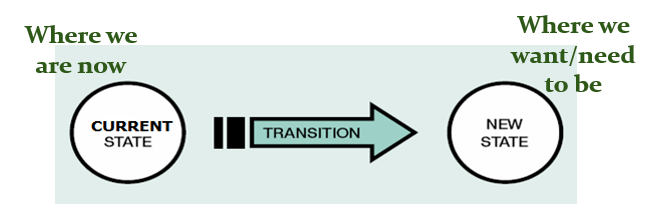
I mentioned previously that a lot of traditional change management models seem to boil down to how to move from A (where we are now) to B (where we want to be).

In order to know where we want to go, we first have to understand where we are now. What’s our current situation, and how then might we need to change to have a better future?
A well-known tool for getting a better understanding of where you, your team, or your organisation is now, is a SWOT analysis. You’ve probably already heard of this, or completed one in your workplace. This is where you brainstorm your current Strengths, Weaknesses, Opportunities and Threats.
Your strengths and weaknesses are internal factors A useful starting point is to ask yourself questions for each section. For example, if you were doing this for your own personal development you could ask:
Strengths – What am I good at? What do I find easy? What knowledge do I have? What do people praise me for?
Weaknesses – What do I struggle with? What do I hate doing? Where are gaps in my knowledge?

Opportunities and threats are external factors I’ve already talked about using PEST to analyse your current environment, and the outcome of your PEST analysis can help you complete the Opportunities and Threats sections of your SWOT analysis.
Beware subjectivity!
We are often unaware of our real strengths and weaknesses. Perhaps because we find something easy, we don’t realise that it’s a strength. Or we have blind spots and we don’t realise the things we are doing that may be holding us back.
So it’s important to gather data for your SWOT to become more aware of what’s really going on. What evidence do you already have, and where might you need more data?
If you’re brave, you can ask friends, family and/or colleagues for feedback to discover how other people view your strengths and weaknesses. You can also take diagnostic tests or complete questionnaires (eg a personality test) to discover more about what you are like. This is where a coach can help, and a programme of coaching or personal development often starts with diagnostic tools or exercises to help you discover more about yourself.
So what?
Like any tool, just completing a SWOT doesn’t give you the answers. But taking the time to think through each of these areas should not only give you a better understanding of your current position (A), it should also start to give you ideas about where you need to go (B). How you can capitalise on your strengths, overcome some of your weaknesses, make the most of any opportunities, and try and minimise the threats?
Further resources:
CIPD (2020) SWOT Analysis
Mind Tools – SWOT Analysis
References
Bassot, B. (2016) The Reflective Practice Guide: an interdisciplinary approach to critical reflection, London: Routledge